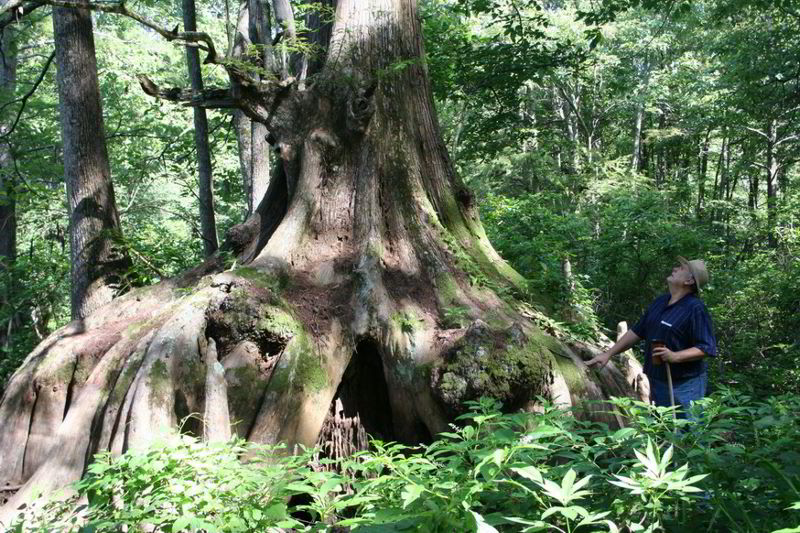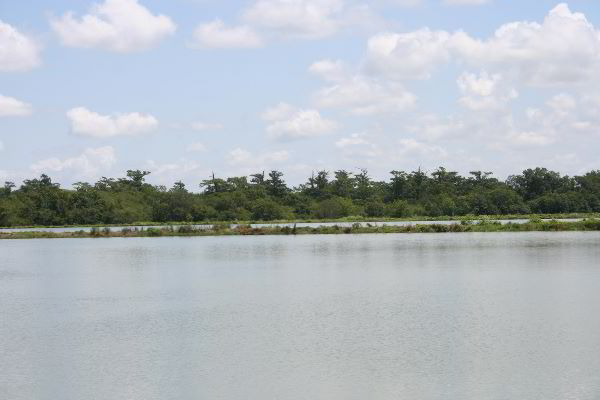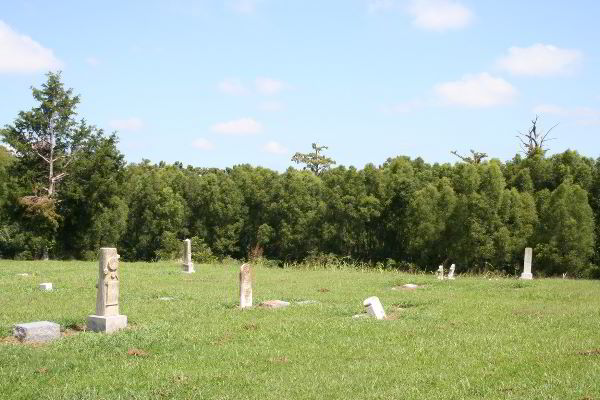| Co-champ
baldcypress in MS |
Jess
Riddle |
| Jul
29, 2007 13:06 PDT |
Gary,
A photograph of that new champion baldcypress appears in the
2006-2007
National Register of Big Trees. The tree has an exceptionally
flared
base, even for a cypress. If you've ever played the board game
Sorry,
the tree's trunk has much the same same as the pieces players
move
around the board in that game. Sounds like the site Don knows
about
probably has more impressive trees
Jess
On 7/6/07, gary-@bellsouth.net
<gary-@bellsouth.net>;
wrote:
| |
I noticed on the big tree list at American Forests that
there is now a
co-champ baldcypress, located in Holmes County, MS. It
actually has a
greater circumference than the Cat Island, LA tree. It
must be right at
17.5 feet dbh, with the other dimensions similiar to the
Cat Island
tree. It might be another out-sized base, fast taper
jobs. I'll have to
go see it.
Gary Smith |
|
| RE:
Co-champ baldcypress in MS |
gary-@bellsouth.net |
| Jul
30, 2007 10:00 PDT |
Jess and ENTS,
I met Don up in Miss this past Saturday and we saw the co-champ
cypress
in Holmes County. Your description of the tree is correct.
It is a nice tree and I'm glad to have seen it.
I really think AF needs to revisit their point system for trees
such as
bald cypress that are subject to having buttressed bases. I've
now seen
the Senator cypress in FL plus the co-champions in LA and Miss
and to my
way of thinking, the Senator easily rules.
Sky Lake WMA is an intriguing area, with quite a few venerable,
old
cypress war horses. We hope to go back at a later date and hope
others
can join us.
I think Don will have a better report at a later date.
Gary
|
| The
big cypress of Mississippi |
Don
Bragg |
| Jul
31, 2007 07:07 PDT |
ENTS--
On Saturday, Gary Smith and I met in the small town of Belzoni,
Mississippi, to hunt down some of the big baldcypress that this
area is
known to have. We were both intrigued by the reports of massive
cypress, and we were both pleased and disappointed with what we
found...
Our first stop was the new American Forests co-national champion
baldcypress just west of the Hillside National Wildlife Refuge
in Holmes
County, MS. After a brief search of the local area trying to
find the
right trail to take, we soon found ourselves looking into a
small slough
surrounded by a stand of baldcypress, water tupelo, sugarberry,
sycamore, and some sweetgum. This stand ranges from fairly high
and dry
to very wet, even during this drought year.
 National Co-Champion Cypress.
National Co-Champion Cypress.
Note the "stump" underneath the root mass.
The champion cypress was easy to spot--having seen pictures of
this
tree, we kind of knew what to expect... The tree makes their
list as
co-champ because of a incredibly wide (even for baldcypress)
buttress--so much so, that I didn't even make an attempt at
measuring
diameter. After this initial swell, which drops drastically at
about 5
feet above the ground, the cypress proves to be of very modest
size. It
reaches about 86 feet tall, but it has all the appearances of a
young
tree (young, of course, being relative for cypress, which can
live to
well over 1,000 years). To me, it seems that this cypress may
have
gotten its start on the stump of an old dead cypress, and then
was able
to cover it over with its own root system. I have definitely
seen many
more impressive cypress than this tree, which was interesting to
see,
but not massive at all.

Sky Lake Slough:
the water visible is not actually part of Sky Lake itself, but some catfish
rearing ponds
located nearby--this image looks back towards a slough
draining into Sky Lake.
We then traveled northwest of this site to Sky Lake Wildlife
Management
Area in northern Humphreys County. We had heard good things
about this
site--all true, by the way, unless the clouds of mosquitoes or
occasional cottonmouth are considered bad... Sky Lake WMA is a
recently
protected area that is chock-full of giant and ancient
baldcypress
(http://www.wildlifemiss.org/news/news/2001/05-16.html).
We parked at
an old cemetery next to the WMA, from which the big cypress
could be
seen towering over a low understory of water locust and what I
think was
water-elm. We skirted the edge of the cemetery and some cropland
before
dropping down off of the higher terrace into a wooded slough
choked with
mosquitoes. This site was still fairly wet, even with the major
drought
Mississippi is experiencing, so we slogged along as best we
could,
regretting with every step that we left our boots behind.

Sky Lake Cemetary
Large baldcypress boles soon started appearing amongst the low
tangle of
hardwoods. We came across a number of nice-sized cypress, almost
all of
them more massive than the co-champ we had seen earlier in the
day.
Most were draped with Spanish moss, and it was obvious that they
were
ancient. We stopped to measure only one cypress--it turned out
to be
32.8 feet in circumference (I couldn't get a height on it due to
the
conditions, but it probably wasn't much more than 80 or 90 feet
tall).
This tree was huge and well worth the journey, but we weren't
able to
find the real bigguns lurking in this swamp--there are at least
a few
out here that go over 40 feet in circumference!! We vowed to
return
later this year, when conditions are better, and we're better
equipped.
After returning to the truck, we then drove around to several
other
vantages points of Sky Lake and its associated sloughs. From
several
points we could see large cypress standing out above the rest of
the
trees--a sure sign of more big cypress reports to come!
We then headed over to the Delta National Forest, which lies
southwest
of Belzoni. North of the small town of Holly Bluff, we crossed
the
parched yet rich farmlands of the Mississippi River Delta to get
to the
Sweetgum Research Natural Area. This is a small tract of timber
that
had been spared from the logging of these bottomland hardwoods.
Historically, it had been dominated by large sweetgum, but
unfortunately
many of these have died in recent decades. The stand still has a
scattering of large, old sweetgum, including one we measured to
be 49.1
inches at DBH and at least 138 feet tall. Most of the rest of
the
canopy oaks and gums aren't this tall--perhaps between 100 and
120 feet.
Still, the stand had a unique feel about it, with its cane and
palmetto
dominated understory growing up out of the clayey, wet soil.

Large Sweetgum and Gary Smith
After a quick walk through the Sweetgum RNA, Gary and I
discussed future
plans to return to the Sky Lake WMA, and then parted ways. As I
reached
the northern end of the Delta National Forest, a large
woodpecker with a
prominent red crest darted from the big timber on one side of
the road
to the other. My pulse quickened as my brain raced through
woodpecker
characteristics... But alas, this was no ivory-bill, as its dark
plumage on its back showed--a male pileated woodpecker. Still,
an
exciting way to conclude the day!
I'll send Ed some pictures from this adventure.
Don
****************************
Don Bragg, Ph.D.
Research forester
Editor, Bulletin of the ENTS
****************************
|
| Re:
The big cypress of Mississippi |
Edward
Frank |
| Jul
31, 2007 16:32 PDT |
Don,
This really seems to be a problem of how the base of the tree is
defined.
The actual base of the tree is atop the old stump if you use the
"where the
acorn sprouted" definition offered by Colby Rucker.
Therefore by this
definition its girth should be measured about five feet further
up the tree.
That would be easy to apply consistently if the nurse logs and
stumps
continued to persist forever. Eventually however they will decay
and the
original position will be lost. If you define the base as the
ground
surface beneath the log or stump, then you are actually
measuring the girth
at a height that is lower by the thickness of the log or height
of the stump
serving as a nurse log. We had a brief discussion of this in a
series of
posts back in 2005:
http://www.nativetreesociety.org/measure/tree_base_position.htm
Basically in
my opinion defining the base of the tree as the existing ground
surface
supporting the tree would result in some oddball cases like
this, but would
be workable overall without the need for interpretations of what
was the
actual initial growing point for these trees sprouted on nurse
logs.
Ed Frank
|
| RE:
The big cypress of Mississippi |
James
Smith |
| Jul
31, 2007 19:18 PDT |
Nice to know that there are stands of big cypress trees still
out there. |
| RE:
The big cypress of Mississippi |
Don
Bragg |
| Aug
01, 2007 05:31 PDT |
Ed--
Gary and I both agreed that while a very interesting tree that
its
owners can be proud of (and they are, we met one at the tree),
this
specimen does not rise to the ranks of a champion because of the
quirkiness of the base. I also agree that a different set of
rules
should apply to these trees to avoid this problem.
I don't know for sure if the tree is growing on a large stump,
but when
you get the pictures I sent, the one with Gary standing next to
the tree
also clearly has a small "window" in the base that
exposes decayed wood
that looked to me to be part of a stump...no way to confirm this
without
closer examination, but it could explain the extremely swollen
base.
Don Bragg
|
| RE:
The big cypress of Mississippi |
wad-@comcast.net |
| Aug
01, 2007 09:17 PDT |
Don,
Ed, ENTS
(this is not a hostile comment, read as a relaxed discussion)
I don't think there is any way to level the playing field for
how a tree got it's start. Most Hemlocks in old stands get there
start on a nurse log. I saw similar starts for young trees
(sweet gum, black gum, magnolia) in Bear swamp NJ. If a tree
starts out on a 10'cbh fallen log as compared to a 1'cbh log,
how can we possibly determine this 50, 100, 300 years down the
road. The champion programs are not scientific, they are hobby
based. The contest is based on bigness, not age, volume, or any
other principle. I agree heights could be recorded more
accurately and girths of multistemmed trees are sometimes
mistakes, and I am glad I met all of you to make me better at
getting the measurements right. I just don't think there is an
effective way to even it all out. If that tree is growing over
an old stump, so be it. Maybe the other bald cypress have too,
just smaller ones. With all of that said, the cypress' that were
reported on are big and beautiful. This is one of the re
asons I include several of each species in the Pennsylvania
list, not just the biggest and those within ten points. A tree
that is 20 points shy is still impressive to me.
Scott
|
| RE:
The big cypress of Mississippi |
Will
Blozan |
| Aug
01, 2007 12:19 PDT |
ENTS,
I agree, the origin of a tree's base is not always possible to
ascertain as
time goes on.
How do these cypress trees compare on the TDI system? I don't
have the
current dimensions (or maxima). To settle this we need the ENTS
measurements
of the "Senator" (I have girth and height; spread
anyone?) and "The Turnip".
Does "The Turnip" represent the maximum girth known
for baldcypress? The
tallest known is in Congaree NP. Anyone have a max spread for
bald cypress?
Will
|
|